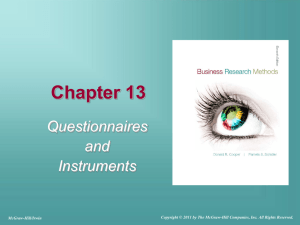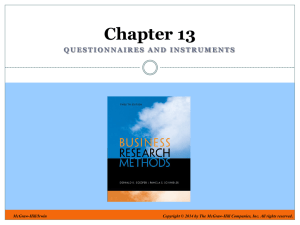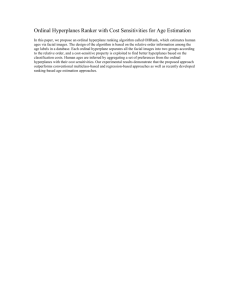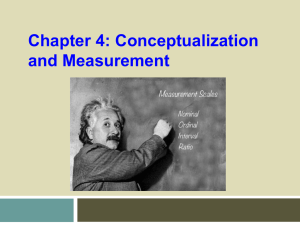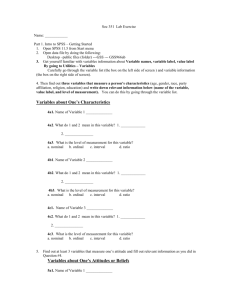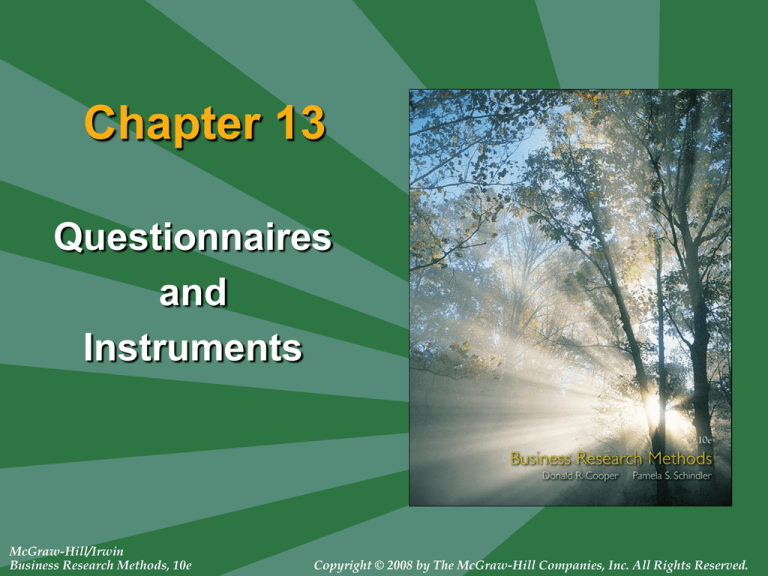
Chapter 13
Questionnaires
and
Instruments
McGraw-Hill/Irwin
Business Research Methods, 10e
Copyright © 2008 by The McGraw-Hill Companies, Inc. All Rights Reserved.
13-2
Learning Objectives
Understand...
• The link forged between the management
dilemma and the communication instrument
by the management-research question
hierarchy.
• The influence of the communication method
on instrument design.
• The three general classes of information
and what each contributes to the
instrument.
13-3
Learning Objectives
Understand . . .
• The influence of question content, question
wording, response strategy, and preliminary
analysis planning on question construction.
• Each of the numerous question design issues
influencing instrument quality, reliability, and
validity.
• The sources for measurement questions
• The importance of pretesting questions and
instruments.
13-4
Overall Flowchart for Instrument Design
Flowchart for Instrument Design
Phase 1
13-5
13-6
Strategic Concerns in Instrument Design
What type of scale is needed?
What communication approach will be used?
Should the questions be structured?
Should the questioning be disguised?
Technology Affects
Questionnaire Development
13-7
• Write questionnaires
more quickly
• Create visually driven
instruments
• Eliminate manual
data entry
• Save time in data
analysis
WebSurveyor used to write an instrument.
13-8
Disguising Study Objectives
Reluctantly shared,
Conscious-level
information
Willingly shared,
Conscious-level
information
Situations
where
disguise is
unnecessary
Knowable,
Limited-consciouslevel information
Subconscious-level
information
Dummy Table for
American Eating Habits
Use of Convenience Foods
Age
18-24
25-34
35-44
55-64
65+
Always Use
Use
Frequently
Use
Sometimes
Rarely Use
Never Use
13-9
Flowchart for Instrument Design
Phase 2
13-10
Question Categories
and Structure
Administrative
Classification
Target
13-11
13-12
Question Content
Should this question be asked?
Is the question of proper scope and coverage?
Can the participant adequately
answer this question as asked?
Will the participant willingly
answer this question as asked?
13-13
Question Wording
Adequate
alternatives
Shared
vocabulary
Criteria
Personalized
Biased
Single
meaning
Misleading
assumptions
13-14
Response Strategy
Objectives
of the study
Participant’s
motivation to
share
Ease and clarity with
which participant
communicates
Factors
Participant’s
level of
information
Degree to which
participants have
thought through topic
13-15
Free-Response Strategy
What factors influenced your enrollment in Metro U?
____________________________________________
____________________________________________
13-16
Dichotomous Response Strategy
Did you attend the “A Day at College” program at Metro U?
Yes
No
13-17
Multiple Choice Response Strategy
Which one of the following factors was most influential
in your decision to attend Metro U?
Good academic standing
Specific program of study desired
Enjoyable campus life
Many friends from home
High quality of faculty
13-18
Checklist Response Strategy
Which of the following factors influenced
your decision to enroll in Metro U? (Check all that apply.)
Tuition cost
Specific program of study desired
Parents’ preferences
Opinion of brother or sister
Many friends from home attend
High quality of faculty
13-19
Rating Response Strategy
Strongly
influential
Somewhat Not at all
influential influential
Good academic reputation
Enjoyable campus life
Many friends
High quality faculty
Semester calendar
13-20
Ranking
Please rank-order your top three factors from the following list based on their
influence in encouraging you to apply to Metro U. Use 1 to indicate the most
encouraging factor, 2 the next most encouraging factor, etc.
_____ Opportunity to play collegiate sports
_____ Closeness to home
_____ Enjoyable campus life
_____ Good academic reputation
_____ High quality of faculty
13-21
Summary of Scale Types
Type
Restrictions
Scale
Items
Scale
points
Data Type
Rating Scales
Simple
Category
Scale
Needs mutually exclusive choices
One or
more
2
Nominal
Multiple
Choice SingleResponse
Scale
Needs mutually exclusive choices; may
use exhaustive list or ‘other’
many
2
Nominal
Multiple
Choice
MultipleResponse
Scale
(checklist)
Needs mutually exclusive choices; needs
exhaustive list or ‘other’
many
2
Nominal
Likert Scale
Needs definitive positive or negative
statements with which to agree/disagree
One or
more
5
Ordinal
Likert-type
Scale
Needs definitive positive or negative
statements with which to agree/disagree
One or
more
7 or 9
Ordinal
13-22
Summary of Scale Types
Type
Restrictions
Scale
Items
Scale
points
Data Type
Semantic
Differential
Scale
Needs words that are opposites to anchor
the graphic space.
One or
more
7
Numerical
Scale
Needs concepts with standardized or
defined meanings; needs numbers anchor
the end-points or points along the scale;
score is a measurement of graphical
space from one anchor.
One or
many
3-10
Ordinal or
Interval
Multiple
Rating List
Scale
Needs words that are opposites to anchor
the end-points on the verbal scale
Up to
10
5-7
Ordinal
Fixed Sum
Scale
Participant needs ability to calculate total
to some fixed number, often 100.
Two or
more
none
Interval or
Ratio
Stapel Scale
Needs verbal labels that are operationally
defined or standard.
One or
more
10
Ordinal or
Interval
Graphic
Rating Scale
Needs visual images that can be
interpreted as positive or negative
anchors; score is a measurement of
graphical space from one anchor.
One or
more
none
Ordinal
Ordinal
(Interval, or
Ratio)
13-23
Summary of Scale Types
Type
Restrictions
Scale
Items
Scale Data Type
points
Ranking Scales
Paired
Comparison
Scale
Number is controlled by participant’s
stamina and interest.
Up to
10
2
Forced
Ranking
Scale
Needs mutually exclusive choices.
Up to
10
many
Comparative
Scale
Can use verbal or graphical scale.
Up to
10
Ordinal
Ordinal or
Interval
Ordinal
13-24
Internet Survey Scale Options
13-25
Internet Survey Scale Options
13-26
Internet Survey Scale Options
13-27
Sources of Questions
• Handbook of
Marketing Scales
• The Gallup Poll
Cumulative Index
• Measures of
Personality and
Social-Psychological
Attitudes
• Measures of Political
Attitudes
• Index to International
Public Opinion
• Sourcebook of Harris
National Surveys
• Marketing Scales
Handbook
• American Social
Attitudes Data
Sourcebook
Flowchart for Instrument Design
Phase 3
13-28
13-29
Guidelines for Question Sequencing
Interesting topics early
Classification questions later
Sensitive questions later
Simple items early
Transition between topics
Reference changes limited
13-30
Illustrating the Funnel Approach
• How do you think this country is getting along in
its relations with other countries?
• How do you think we are doing in our relations
with Iran?
• Do you think we ought to be dealing with Iran
differently than we are now?
• (If yes) What should we be doing differently?
• Some people say we should get tougher with
Iran and others think we are too tough as it is;
how do you feel about it?
13-31
Branching Question
13-32
Components of Questionnaires
13-33
MindWriter Survey
13-34
Overcoming Instrument Problems
Build rapport
Redesign question process
Explore alternatives
Use other methods
Pretest
13-35
Key Terms
•
•
•
•
•
•
Administrative question
Branched question
Buffer question
Checklist
Classification question
Dichotomous question
•
•
•
•
•
•
Disguised question
Double-barreled question
Free-response question
Interview schedule
Leading question
Multiple-choice question
13-36
Key Terms
•
•
•
•
•
Pretesting
Primacy effect
Ranking question
Rating question
Recency effort
• Screen question
• Structured response
• Target question
– Structured
– Unstructured
• Unstructured response

